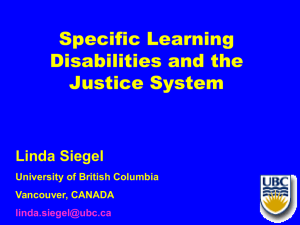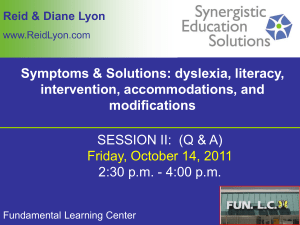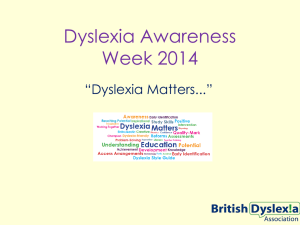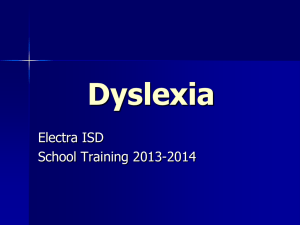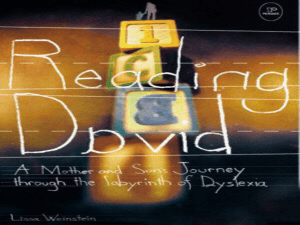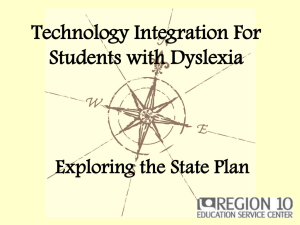Dyslexia Screening Test in Bahasa Malaysia Presentation
advertisement
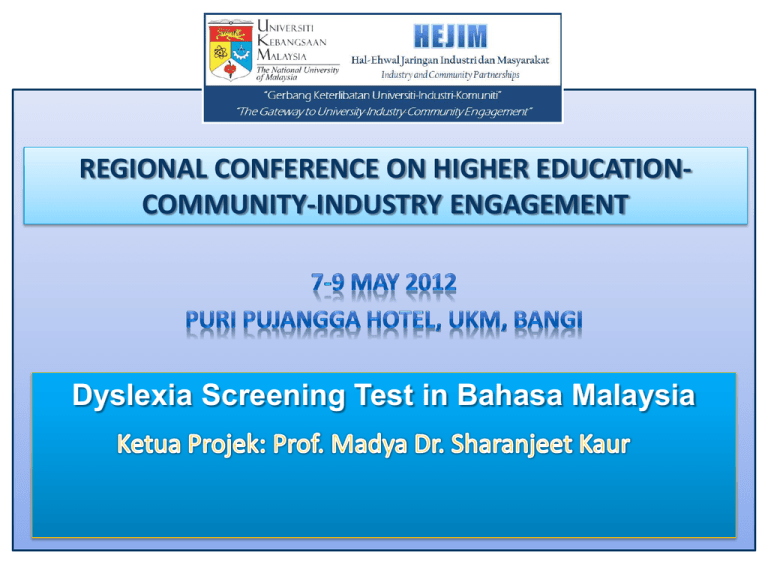
REGIONAL CONFERENCE ON HIGHER EDUCATIONCOMMUNITY-INDUSTRY ENGAGEMENT Dyslexia Screening Test in Bahasa Malaysia Literacy Rate among Year 1 Children at the end of 2010 Illiterate 15% Literate 85% (PEMANDU, 2011) 7 % of standard 2 Malay children were found to have dyslexia (Gomez 2000) 4.43% of undergraduate university students were found to have dyslexia (Ong et al. 2009) • Presently - no Malaysian standardized instruments to identify children with specific • The checklist (‘Senarai Semak reading difficulties. Disleksia’) consists of three elements: • In March 2001, the – (i) pupils’ level of mastery in reading Ministry of Education and writing (spelling) and numeracy officials formulated a skills (difficulties); checklist for screening – (ii) teachers’/parents’ perception of pupils’ abilities (strengths); and all Malaysian children in – (iii) predictors of dyslexia. Standard 1. Objectives • To develop and validate the Dyslexia Screening Test Bahasa Malaysia (DSTBM). • To determine the effectiveness of the DSTBM to identify dyslexic children. • To determine the visual status of children with dyslexia. • To determine the language and literacy abilities of children with dyslexia. • To determine the auditory status of children with dyslexia. • To determine the internalizing and externalizing problems of children with dyslexia. Dyslexia Screening Test Bahasa Malaysia (DSTBM) • Adapted from Fawcett & Nicolson (1996) and developed by lecturers from multidisciplinary field of Faculty of Health Sciences, Universiti Kebangsaan Malaysia. • For school professionals • Wan Nor Azlen (2004) provides norms for 8-yearold children. • Psychometric properties has not been reported. Study Design & Sample • • • • • Cross-sectional design Standard 2 children – 7:6 – 8:6 (n= 501) Cluster sampling 5 Sekolah Kebangsaan at Klang Valley area Received at least 15 months of formal instruction. DSTBM has 11 subsets: 1. Rapid naming 2. One minute reading 3. Two minutes spelling 4. Postural stability 5. Bead Threading 6. One minute writing 7. Nonsense passage reading 8. Phonemic segmentation 9. Semantic fluency 10. Verbal fluency 11. Backward digit span RESULTS Number of children at-risk (At-risk Quotient > 1.0) ARQ > 1.0 15% ARQ < 1.0 85% Cronbach’s Alpha of DSTBM Cronbach's Alpha if Item Deleted Rapid Naming 0.782 Bead Threading 0.814 One Minuet Reading 0.742 Postural Stability 0.824 Phonemic Segmentation 0.752 Two Minutes Spelling 0.750 Backward Digit Span 0.784 Nonsense Passage Reading 0.764 One Minute Writing 0.761 Verbal Fluency 0.759 Semantic Fluency 0.777 Overall Cronbach’s Alpha 0.792 Lack of awareness in Parents & Teachers Challenges of the project High dropout rate for diagnosis Lack of human resources for diagnostic Benefits of community Confirmed Dyslexia Educational Placement Intervention Planning Benefits of community FUTURE Helpful tool for teachers at school level to determine whether a student needs further evaluation by clinical or educational psychologist. EARLY DETECTION EARLY INTERVENTION – now also in planning Before the dyslexics lose their self-esteem Conclusions • With the exclusion of Postural Stability subtest and Bead Threading subtest, DSTBM is currently a reliable and valid dyslexia screening instrument for eight-year-old Malay speaking children. Who are the dyslexics?






